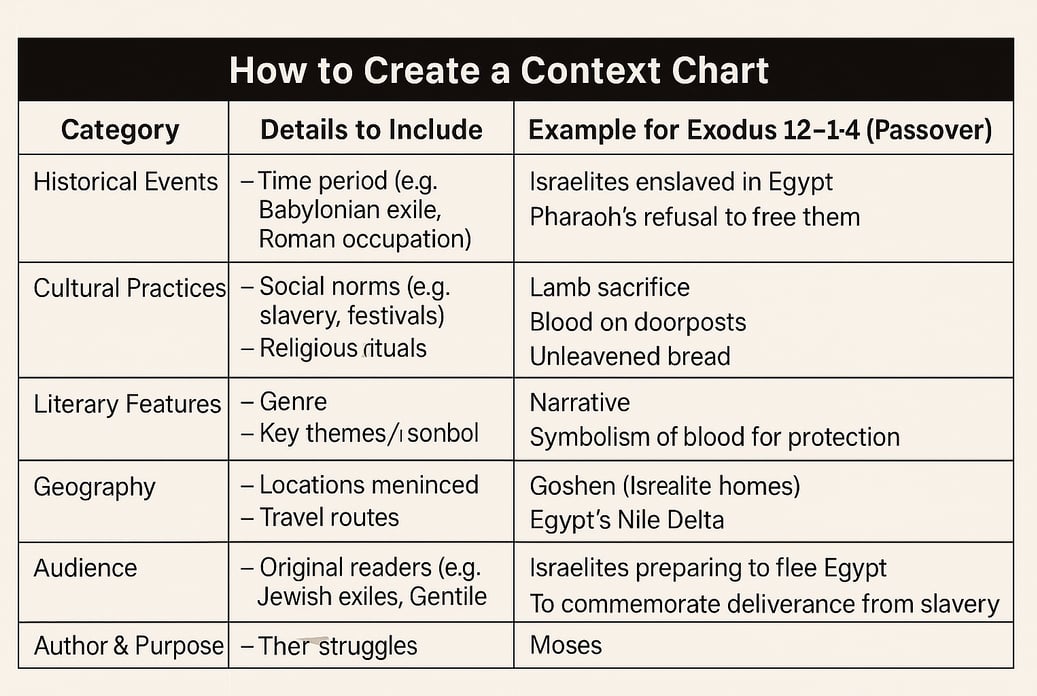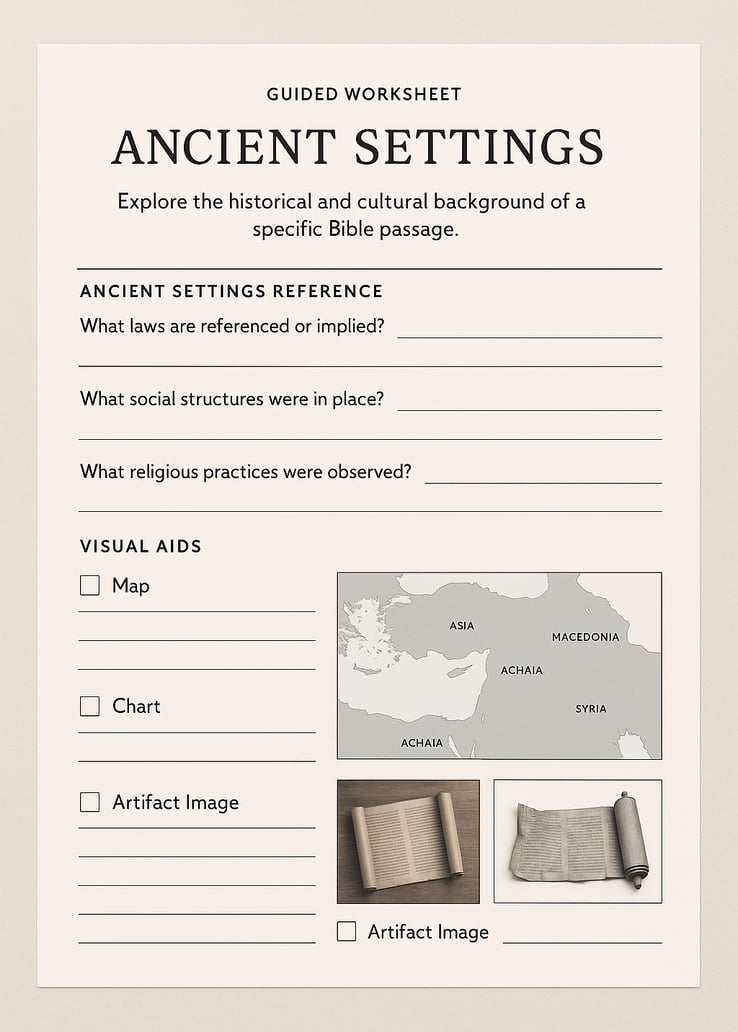Contextual & Historical Bible Study Methods
Discover how understanding the world of the Bible deepens your grasp of Scripture. By exploring the historical and cultural contexts in which biblical events unfolded, you gain a clearer, more accurate interpretation of God’s Word. This page introduces essential tools, sources, and methods—including chronological study and custom guides for ancient settings—to help you see Scripture through the eyes of its original audience, protecting you from misinterpretation and enriching your faith journey.


Importance of Historical Context
Every word of the Bible was written at a specific point in history, shaped by the culture, politics, and daily life of its original audience. Understanding this context helps you interpret Scripture accurately, revealing the intended meaning and relevance for both ancient and modern readers.
Reflective Question:
Who wrote this? When and where? What was happening in their world?
Historical-Cultural Study: Tools and Sources
Enrich your study with tools designed to uncover the background of Scripture.
Study Resources:
Study Bibles: Offer historical notes and cultural insights.
Commentaries: Provide expert analysis on cultural settings.
Online Tools: Sites like Blue Letter Bible and scholarly databases provide accessible background information.
Cultural Backgrounds Bible: A recommended resource for exploring ancient customs and historical context.
Study Tip:
Create a context chart for each passage, listing key historical events, cultural practices, and literary features.
How to Create a Context Chart
1. Identify the Passage
Select a specific verse or passage (e.g., Exodus 12:1-14, 1 Peter 2:18, or Colossians 1:1-14).
2. Research and Fill Out the Chart
Use the following template, drawing from study Bibles, commentaries, and tools like Blue Letter Bible or BibleHub:


3. Apply Your Findings
Interpretation: Use the chart to answer, “What did this mean to the original audience?”
Example: The Passover lamb’s blood (Exodus 12:13) symbolized God’s protection from judgment, countering Egyptian gods associated with lambs.Application: Ask, “How does this truth apply today?”
Example: Trusting in Christ’s sacrifice for spiritual deliverance, not just physical safety.
Tools to Build Your Chart
Study Bibles (e.g., Cultural Backgrounds Study Bible) for historical notes.
Commentaries (e.g., D.A. Carson, Craig Keener) for scholarly insights.
Online Resources:
Blue Letter Bible (lexicons, timelines).
BibleHub.com (cross-references, word studies).
Maps/Atlases to visualize geography.
Why This Matters
Prevents misinterpretation (e.g., 1 Peter 2:18’s slavery context ≠ modern slavery).
Reveals deeper symbolism (e.g., Egyptian plagues targeting false gods).
Connects ancient truths to modern faith with accuracy.
By using this chart, you’ll ground your study in the Bible’s original context, ensuring richer and more faithful interpretation.
Chronological Study: Understanding the Big Picture
A chronological approach reveals how biblical events fit together historically.
Visual Tools:
Bible Timeline Graphic: Embed or link to a visual timeline (e.g., The Great Adventure Bible Timeline) to show the flow of salvation history.
Interactive Maps: Use Bible atlases or digital platforms to trace biblical geography.
An example of using interactive maps for biblical geography is found with digital platforms such as iBible Maps or Bible Atlas. For instance, if you are studying the journey of the Israelites from Egypt to Canaan, you would open iBible Maps and select the Exodus route. The map then displays an animated path highlighting each major location, such as Goshen, the Red Sea, Mount Sinai, and the Jordan River. Each location is clickable, providing a brief summary of what happened there according to the biblical narrative, along with supporting Scripture references. This allows you to visually follow the progress of the Israelites and understand the physical challenges and significance of each place.
Another example is using the GeoBible platform to explore Paul’s missionary journeys. By selecting “Paul’s First Missionary Journey,” you see a detailed map marked with cities like Antioch, Cyprus, and Derbe. As you hover over or click each city, you access information about the events that took place there, who Paul met, and relevant Bible passages. This approach helps you grasp the scope and impact of Paul’s travels, as well as the cultural and historical context of each region.
Bible Geocoding is a further example, where you can download a file for use in Google Earth. Once imported, this file overlays biblical locations onto a modern satellite map. You can zoom in on places like Jerusalem or Ephesus, view historical reconstructions, and see how the geography influenced the events described in Scripture.
These examples demonstrate how interactive maps bring biblical stories to life by visually connecting events with their geographical settings, making the study of Scripture both engaging and informative.


3. Apply Your Findings
Interpretation: Use the chart to answer, “What did this mean to the original audience?”
Example: The Passover lamb’s blood (Exodus 12:13) symbolized God’s protection from judgment, countering Egyptian gods associated with lambs.Application: Ask, “How does this truth apply today?”
Example: Trusting in Christ’s sacrifice for spiritual deliverance, not just physical safety.
Tools to Build Your Chart
Study Bibles (e.g., Cultural Backgrounds Study Bible) for historical notes.
Commentaries (e.g., D.A. Carson, Craig Keener) for scholarly insights.
Online Resources:
Blue Letter Bible (lexicons, timelines).
BibleHub.com (cross-references, word studies).
Maps/Atlases to visualize geography.
Why This Matters
Prevents misinterpretation (e.g., 1 Peter 2:18’s slavery context ≠ modern slavery).
Reveals deeper symbolism (e.g., Egyptian plagues targeting false gods).
Connects ancient truths to modern faith with accuracy.
By using this chart, you’ll ground your study in the Bible’s original context, ensuring richer and more faithful interpretation.
Custom Study Guides for Ancient Settings
Design or Use Guided Worksheets
Structured worksheets are powerful tools that guide readers to intentionally engage with the historical and cultural background of specific Bible passages. These resources prompt students to ask contextual questions, make detailed observations, and record insights that deepen their understanding of the text.
What These Worksheets Should Include:
1. Ancient Settings Reference
This section provides prompts and spaces for users to document:
Legal systems: What laws were in place at the time? Were they Mosaic laws, Roman civil codes, or local tribal customs?
Social structures: Was the setting patriarchal? Was slavery common? What was the role of women, elders, or kings?
Religious practices: What festivals, sacrifices, or temple customs were being observed? Were there competing pagan rituals nearby?
Example prompt:
“What laws are referenced or implied in this passage? How would the original audience understand these instructions?”
2. Visual Aids for Reinforcement
To make learning more memorable and accessible:
Maps: Include printable or linked maps to locate key cities, regions, or travel routes in the text.
Charts: Create timelines or comparative charts (e.g., comparing Jewish festivals or temple layouts).
Artifact Images: Use visuals of ancient scrolls, altars, coins, or clothing to help visualize the passage's setting.
Example use:
A student reading about Paul in Corinth might refer to a map of Roman provinces, a chart of Greco-Roman temple worship, and an image of a Corinthian marketplace.
Optional Enhancements:
Include checkboxes or short-answer sections for note-taking.
Provide a sample worksheet based on a well-known passage, such as Ruth 1 or Acts 17.
Offer both print-ready PDF versions and editable digital formats.
You can use ChatGPT to generate images like the one below. In this graphic, you can see a basic hallucination: the map has misplaced Macerdonia. The next step would be to interact with ChatGPT to correct the map.


Interpreting in Light of Historical Background
Apply Your Contextual Insights to Deepen Interpretation
Once you’ve gathered historical, cultural, and geographical information, the next step is to interpret the passage through the lens of that context. Understanding how the original audience would have heard and responded to the message allows you to move from shallow assumptions to deeper, more accurate comprehension. It also guards against misapplication and provides a stronger foundation for personal and communal spiritual growth.
Key Approaches to Apply Contextual Interpretation:
1. Context-First Reading
Begin your study by reviewing the background information you’ve gathered about the passage. This includes:
When and where it was written.
The life circumstances of the original audience.
The cultural assumptions or practices referenced in the text.
This “pre-study” phase helps prevent reading modern ideas into ancient texts. You’re less likely to misinterpret a command or principle when you understand its original setting.
Example:
Reading Paul’s instructions to slaves in 1 Peter 2:18 without understanding the structure of Roman household codes might result in misapplying the passage today. A context-first reading frames the text within the limitations, abuses, and assumptions of its time.
2. Cross-References for Depth
Comparing related passages enhances your ability to see the consistent threads of God’s message across different books, authors, and eras.
Use cross-references to:
Clarify confusing terms or imagery.
See how New Testament writers interpreted Old Testament laws, events, or people.
Detect progression or continuity in theological themes.
Example:
The blood of the Passover lamb (Exodus 12) gains deeper significance when cross-referenced with Jesus as the Lamb of God (John 1:29; 1 Corinthians 5:7).
3. Modern Application with Contextual Integrity
Once you’ve explored what the text meant to the original audience, ask what truths still apply today—while avoiding the mistake of importing modern assumptions or moral standards into ancient settings.
Steps for Application:
Identify the timeless principle.
Translate that principle into a contemporary equivalent.
Apply it specifically to your life, community, or culture.
Example:
Understanding the cultural value of hospitality in the ancient Near East (e.g., Genesis 18) sheds light on biblical expectations around generosity, honor, and protection of guests—principles that still matter but may look different in modern societies.
4. Group Discussion to Broaden Perspective
Bring your contextual findings to small groups or Bible studies. Discussing what you’ve discovered allows:
Others to ask questions that refine your understanding.
Group members to share additional insights or supporting references.
A collective pursuit of biblical truth that is less prone to individual bias.
Encourage members to:
Compare cultural backgrounds they discovered.
Explore how historical insights shifted their interpretation.
Consider how application may vary based on differing life experiences.
Conclusion:
Historical interpretation isn’t academic busywork—it’s a pathway to spiritual clarity. When you ground your reading in the world of the Bible, your understanding becomes both richer and more responsible. Let context serve as the bridge between Scripture’s original meaning and your faithful application today.
